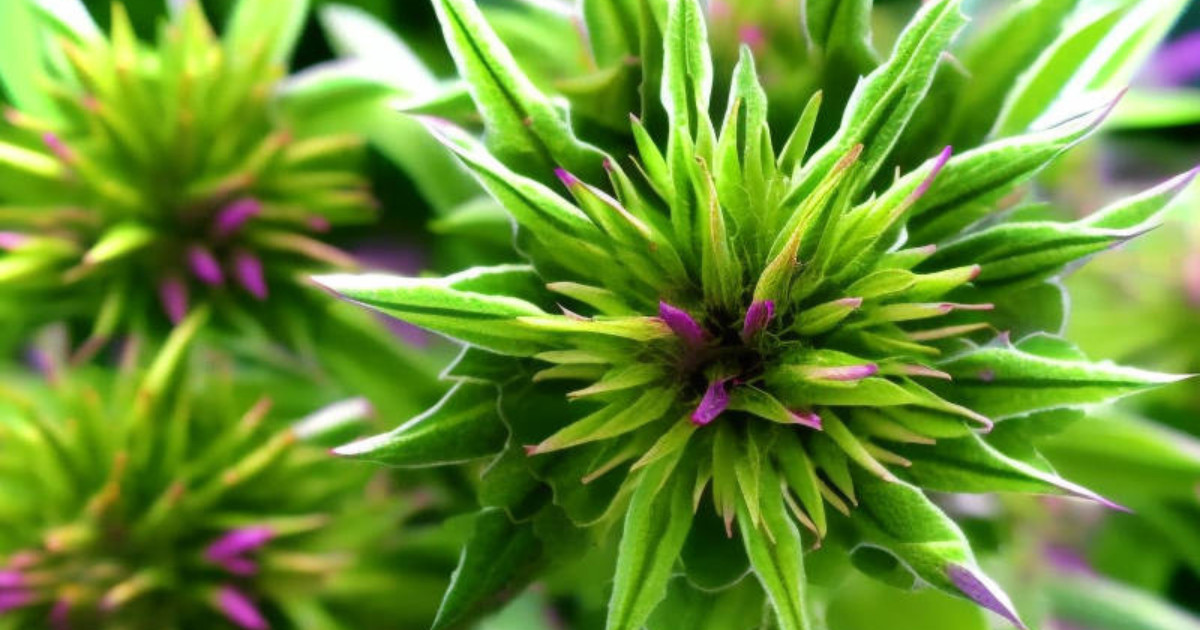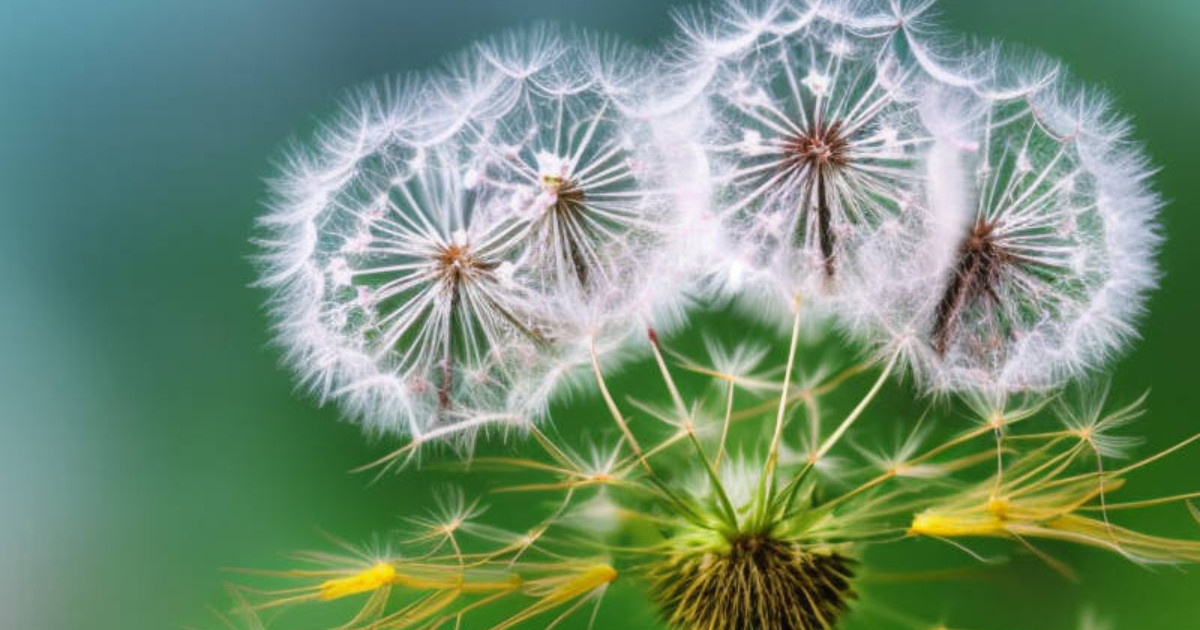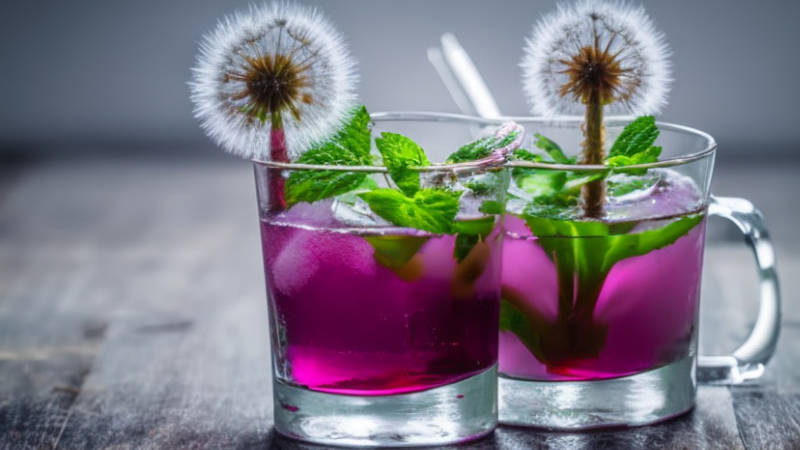Both burdock and dandelion have a variety of potential health benefits. Both are plants that have been used in traditional medicine for centuries, but they are quite different in terms of their appearance, uses, and nutritional properties.
I can recall when I first tried burdock in England as a teenager. My Father always spoke about a soda he had in his younger years as a treat – Dandelion and Burdock. This being something of a legacy, I had to give it a shot. Sugar rush city!
Suffice it to say that it was very sweet as a soda, not at all like the kind of thing my Grandmother made. She avoided using sugar as much as possible. But, according to many locals, even this soda version of the drink was considered to be something of a tonic.
Table of Contents
What’s the Difference Between Burdock and Dandelion?
Burdock is a biennial plant that can grow up to six feet tall. It has large, heart-shaped leaves and purple or pinkish-white flowers that bloom in the summer.
The root of the burdock plant is the part that is most commonly used in traditional medicine. It is a common ingredient in many herbal remedies and is often used to treat a wide range of ailments, including skin conditions such as eczema and acne, as well as respiratory and urinary tract infections.
Dandelion, on the other hand, is a perennial plant that is often considered a weed. It has bright yellow flowers that bloom in the spring and summer, and it is commonly found in meadows, pastures, and along roadsides.
The leaves, flowers, and roots of the dandelion plant are all used in traditional medicine.
Dandelion is often used as a natural remedy for various health issues. It is a rich source of vitamins A, C, and K, as well as minerals such as iron and potassium. It also comprises antioxidants that may assist in safeguarding against cellular harm. 1 2
Burdock is considered to be a root vegetable, while dandelion is considered to be a common weed.
Both have been traditionally used as a natural remedy for health issues but have different nutritional properties and different parts of the plant are used.
Benefits Associated with Burdock and Dandelion Root
Both burdock and dandelion are believed to have a wide range of potential health benefits. Some specific benefits that have been associated with them include:
- Burdock:
- Dandelion:
- Rich source of vitamins A, C, and K, as well as minerals such as iron and potassium 6
- Contains antioxidants, which can help to protect against cellular damage 7
- Often used as a diuretic to help flush out excess water and toxins from the body 8
- May also help to improve digestion and reduce inflammation, and 9
- Traditionally used to help with liver health and to help detoxify the body. 10
Using Burdock and Dandelion as Ingredients
Both burdock and dandelion have various parts of the plant that can be used as ingredients in traditional medicine, cooking, and other uses.
A consideration to keep in mind is the burs on burdock can irritate if they are attempted to be consumed.

Burdock:
- The root is the most commonly used part of the burdock plant in traditional medicine and cooking. It is often used to make tea, extract, and tinctures.
- In cooking, the root is often sliced and used in soups, stews, and stir-fries.
Taste: Burdock root can be quite earthy.

Dandelion:
- The leaves, flowers, and roots of the dandelion plant are all used in traditional medicine and cooking.
- The leaves are often used to make tea, salads, and sandwiches.
- Dandelion flowers can be used to make wine, jelly, and fritters.
- The roots are often used to make tea and coffee substitutes and also to make extracts, tinctures, and capsules.
Taste: Dandelion leaves can be quite bitter, and the taste of roots can be very earthy.
Making Your Own Teas
Ok, so let’s assume that you want to make your own dandelion and burdock tea, and you intend to forage for these plants and roots. First, there are some considerations to keep in mind.
Please note that these tips do not form a complete guide, and they are not an endorsement or encouragement for you to go looking for plants to use. But if you are set on doing this, consider the following:
- Only gather plants from areas that you know have not been sprayed with chemicals or exposed to contaminants. This can include pesticides, herbicides, and other substances.
- Also, often the history of the land is important. Knowing if a disused block was once a site where chemicals were used can help you avoid complications. Some land is too contaminated to even build on, and you don’t want to consume anything that is growing on this type of property.
- Only gather what you know is the right plant – there are often lookalikes that can be harmful and misidentification is a high possibility (that’s one of the reasons why we’ve created supporting articles in this series).
- Keep in mind any necessary legal considerations; are you entering someone else’s property without permission?
- Other risks such as wildlife and unfamiliar territory, both of which may contribute to a potential risk of injury. Trust me, venomous snake bites are not fun.
Once you have your dandelion and burdock, tea can be made using either the roots or the leaves of the plants. For some easy-to-follow recipes on how you can do this yourself, check out our:
- Dandelion Root Tea Recipe
- Dandelion Leaf Tea Recipe
- Burdock Root Tea Recipe
A big part of why we chose to partner with HerbiTea is that we trust their processes for sourcing reliable ingredients, and we aren’t interested in making the wrong call on identifying a plant. Both dandelion and burdock are ingredients that can be found in two of the HerbiTea Tea Blends.
- Dandelion is in HerbiTea Anti-Inflammatory Tea Blend
- Burdock is in HerbiTea Iron Fluorine Tea Blend
Are They Alcoholic?
Is dandelion and burdock alcoholic? Dandelion and burdock themselves are not alcoholic, but they can be used in making alcoholic beverages.
These are not the traditional medicinal uses of these plants.
Dandelion wine is made by fermenting the flowers of the dandelion plant, along with other ingredients such as sugar, lemon, and yeast. It is considered a folk wine, and it has a yellow colour, a sweet taste, and a low alcohol content.
Burdock is not traditionally used to make an alcoholic beverage. However, it can be used to make a beer called Burdock Beer, which is a non-alcoholic, root beer-like beverage that is made from the roots of the Burdock plant and other ingredients such as sarsaparilla and licorice root.
It’s important to note that consuming excessive amounts of alcohol can be dangerous and harmful to your health. If you do choose to consume alcohol, we would suggest that you only do so in moderation and drink responsibly.
Sourcing Dandelion and Burdock
If you’re looking for dandelion and burdock where to buy quality products, it matters to consider the source.
Keep in mind that if someone is out foraging for these themselves, they may be getting their plants from questionable areas. See the 5 tips we shared earlier on things to keep in mind when foraging.
Dandelion and burdock roots can be found in various forms and they can be purchased from a variety of sources. Here are a few options:
- Health food stores
- Many health food stores carry dandelion and burdock root in the form of supplements, teas, and tinctures. You can also find Dandelion and Burdock drinks in these stores.
- Online retailers
- Many online retailers sell dandelion and burdock products. Some popular online retailers include Amazon, iHerb, and Thrive Market. Keep in mind that you still need to trust the Manufacturer and the Seller.
- Specialty stores
- Some specialty stores carry these products too, you can find them at some herbalist or natural food stores.
- From local farmers
- If you live in an area where dandelion and burdock grow wild, you can harvest them yourself as long as you know what you’re doing. Be sure to identify the plants correctly and sustainably harvest them.
It’s important to note that before taking any supplement or trying a new drink, it’s always best to consult a healthcare professional. Also, make sure to check the expiration date and storage instructions of the product to ensure maximum quality and safety.
FAQs
What is Burdock and Dandelion good for?
Burdock and dandelion are both plants that have been used in traditional medicine for centuries, and they are believed to have a wide range of potential health benefits.
It has been used to treat a wide range of ailments, including skin conditions such as eczema and acne, as well as respiratory and urinary tract infections.
Dandelion is a rich source of vitamins and minerals. It also contains antioxidants, which can help to protect against cellular damage. It is often used as a diuretic to help flush out excess water and toxins from the body, and it may also help to improve digestion and reduce inflammation.
Can you take Dandelion and Burdock together?
It is possible to take dandelion and burdock together, as both plants have been traditionally used in combination for various health purposes.
Dandelion and burdock may have similar health benefits, such as antioxidant, anti-inflammatory, and diuretic properties, as well as, helping with digestion and liver function.
Is Dandelion and Burdock medicinal?
Dandelion and burdock have been used in traditional medicine for centuries and are believed to have medicinal properties.
However, it is important to note that while these plants have been traditionally used for medicinal purposes, it’s not the same as being scientifically proven. More research is needed to confirm the potential benefits and safety of dandelion and burdock.
What is the drink Dandelion and Burdock made out of?
Dandelion and burdock is a traditional non-alcoholic drink that is made from a combination of the roots of the dandelion and burdock plants, along with other ingredients such as sarsaparilla root, licorice root, and caramel.
The roots are typically cleaned, chopped, and steeped in water, and then combined with sugar and other flavorings to create a sweet and earthy-tasting beverage. The drink is commonly consumed in the United Kingdom, Ireland, and other parts of Europe, and it’s also known as “dandelion and burdock soda” or “dandelion and burdock tonic”.
It is important to note that the recipe for Dandelion and Burdock drink can vary depending on the brand, location, and when making it yourself your personal preference. Some brands may use artificial flavours and colours, so it’s a good idea to check the ingredient list before purchasing.
Conclusion
Burdock and dandelion are two plants with a rich history of use in traditional medicine.
Burdock is a biennial plant whose root is commonly used to treat skin conditions, respiratory and urinary tract infections, and more. Its root is rich in inulin, a type of dietary fiber that can help with digestion and lower cholesterol levels.
Dandelion, on the other hand, is a perennial plant considered a weed. Its leaves, flowers, and roots are all used in traditional medicine and are a rich source of vitamins and minerals. Dandelion is also often used as a natural remedy for various health issues, including improving digestion and detoxifying the body.
Both burdock and dandelion can be used to make tea, extracts, and tinctures, and in cooking, with burdock root having an earthy taste and dandelion leaves being bitter.
Join the Burdock and Dandelion conversation and share your perspective with us on Instagram or Pinterest.
References
- “13 Emerging Health Benefits of Dandelion” – R. Link, A. Hill, A. Seitz, 4 January 2022 [Healthline] [Archive] ↩︎
- “Nutrition Facts Burdock root, raw, 1 root” – University of Rochester Staff, Last Checked 3 February 2023 [University of Rochester] [Archive] ↩︎
- “Burdock” – Mount Sinai Staff, Last Checked 3 February 2023 [Mount Sinai] [Archive] ↩︎
- “Antioxidative and in vitro antiproliferative activity of Arctium lappa root extracts” – F. S. Predes, A. L. T. G. Ruiz, J. E. Carvalho, M. A. Foglio, H. Dolder, 23 March 2011 [PubMed] [Archive] ↩︎
- “Effect of Dose and Timing of Burdock (Arctium lappa) Root Intake on Intestinal Microbiota of Mice” – A. Watanabe, H. Sasaki, H. Miyakawa, Y. Nakayama, Y. Lyu, S. Shibata, 6 February 2020 [PubMed] [Archive] ↩︎
- “Nutrition Facts Dandelion greens, raw, 1 cup, chopped” – University of Rochester Staff, Last Checked 3 February 2023 [University of Rochester] [Archive] ↩︎
- “The chemical composition and antioxidant properties of common dandelion leaves compared with sea buckthorn” – W. Biel, A. Jaroszewska, E. Łysoń, A. Telesiński, 30 May 2017 [Canadian Science Publishing] [Archive] ↩︎
- “The Diuretic Effect in Human Subjects of an Extract of Taraxacum officinale Folium over a Single Day” – B. A. Clare, R. S. Conroy, K. Spelman, August 2009 [PubMed] [Archive] ↩︎
- “Dandelion (Taraxacum officinale L.) as a Source of Biologically Active Compounds Supporting the Therapy of Co-Existing Diseases in Metabolic Syndrome” – M. K. Dobrowolska, J. Baraniak, 29 August 2022 [MDPI] [Archive] ↩︎
- “7 Ways Dandelion Tea Could Be Good for You” – D. R. Wilson, A. Schaefer, 8 February 2019 [Healthline] [Archive] ↩︎
Last Updated on 2 months by D&C Editorial Team


